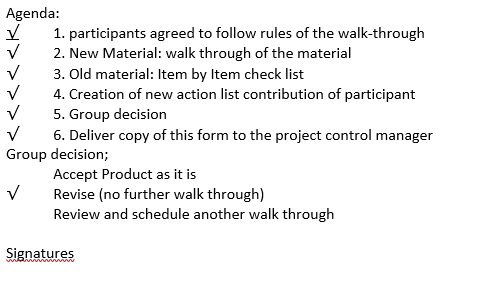Executive Summary
Telstra Corporation embarked on a project aimed at the improvement of its retail services. The management sought the services of CARA interior project Management Company specifically for this project. The project plan is to follow a three to a five-year transformational plan that eventually will help the company achieve a competitive advantage in the retail telecommunications sector. In addition, with the aim of targeting individual users at home, in the office and on mobile devices, the company deemed it fit to integrate the needs of these users at the retail level. The integration at the retail level is mainly to offer customers better-personalized services and interaction with the devices and services before any purchases are made. Based on their long term transformation process called the Telstra T [life] project, the company aims at making its retail outlets reflect their ‘live’ vision.
This report details the proposed project management plan, as agreed upon by Telstra and Cara IPM. It is primarily based on the five project management processes of project initiation, planning, execution, monitoring and control and project closure.
Project Initiation
Business Case for the Project
Telstra Corporation is a media and telecommunication company that prides itself in building networks and the marketing of mobile, voice, pay television and internet access. Founded in 1975 by the postmaster general department, the Company has gone through various organizational changes before acquiring the name Telstra in 1995. Over the years, the Company has grown from the facilities it acquired during the Second World War, to its present international telecommunications standing (Ellis 1). This development has been represented by undersea cable networks, digital technologies and global satellite systems.
According to Ellis, Telstra has undergone major transformational changes in the last five years, which has primarily been driven by the organizational strategy laid down by its directors under the leadership of David Thodey (Ellis 2). Having the need to improve customer service and sales “leadership sought a three to five-year transformational plan, in order to stay ahead of its competition” (Hanlon 12). This broad transformation is mainly focused on both network and retail transformation strategy that will redefine the Company’s outlook and trend.
Telstra’s transformation project began with the network transformation that is founded on a unitary IP-based infrastructure, which would synch the demands of their customers. This step enabled Telstra to reduce its network platform in order to serve more customers on a micro-scale, to include the ever-increasing number of broadband users in Australia. Consequently, Telstra saw an increase of sales to individuals in the home networks and brought Telstra closer to their vision of “I-click, I-touch, I-screen, I-step expression” (Ellis 3).
The second transformational phase, which is detailed in this project is the retail transformation geared towards making Telstra stores more interactive for their customers. According to its retail director, Andy Ellis, the Company aims to focus on retail trends and opportunities as a strategic transformational basis that would create a competitive advantage for the company in the telecommunication sector. The new retail outlook is directed towards creating Telstra stores more live, as they provide customers with interactive devices, from its new telecommunication transformation platform.
According to Hanlon the company provides interactive devices like the iPhone and a wide range of devices from companies like HTC, Samsung and LG, it was deemed fit that Telstra retail stores were also interactive for the customers. This implies that the transformation process requires Telstra’s products to give customer integration from their work, homes and mobile life. The retail transformation project is named the T [life] project and aims at redesigning Telstra stores from their physical layout to the products they showcase. With the assistance of Cara interior Project Management, Telstra will embark on this retail transformation program on the following basis (Ellis 4).
Project Charter
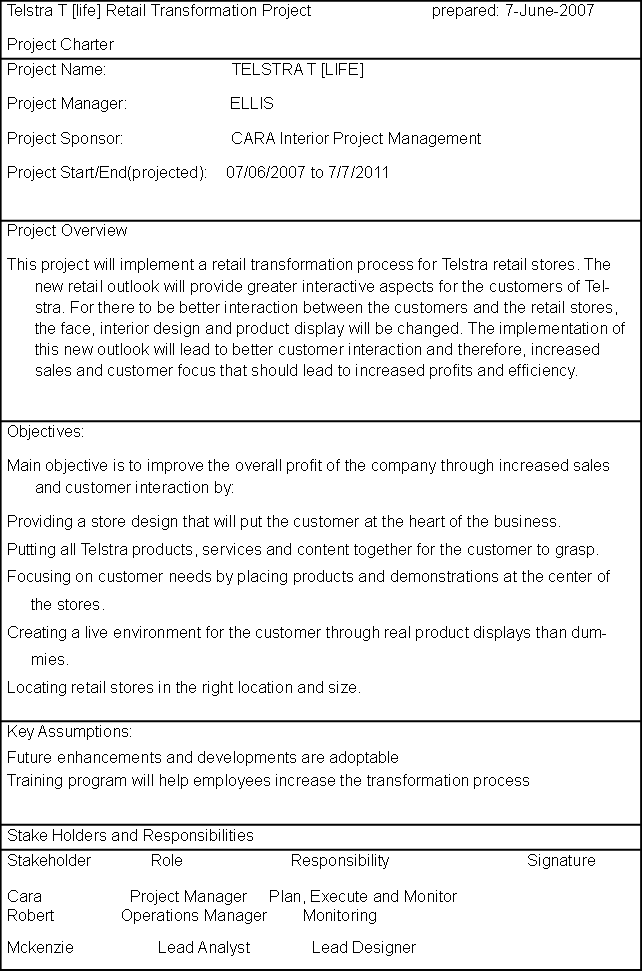
Project Planning
According to Hamilton, the project’s requirements need to be gathered, organized and used in the planning phase (Hamilton 16). In addition, it is in this phase that the scope will be described and be signed by Telstra for the initiation of the project. The major knowledge processes which will occur under the scope are as follows.
Scope Management Plan
Project Scope Statement
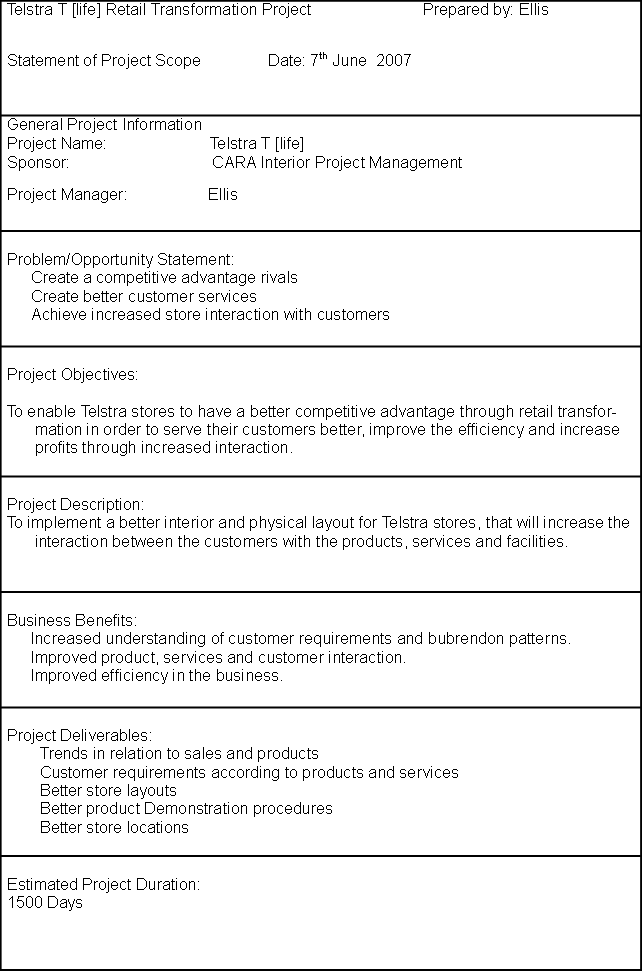
Scope Verification
The project’s Management, developers and other stakeholders will be involved in follow-up meetings in order to make sure that the proposed transformations adhere to organizational standards. At the same time, this will make sure that relevant parties agree with the baseline plan.
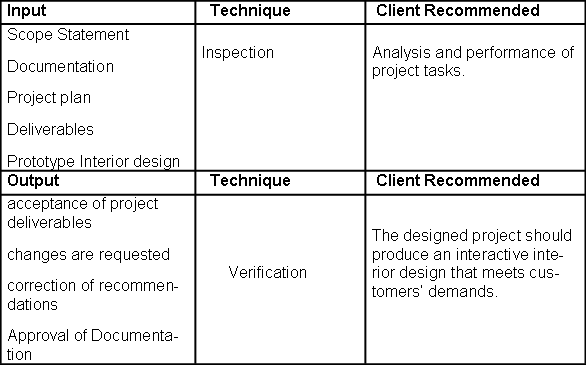
Work Breakdown Structure
The structure of the proposed project is based on a top-down approach where hierarchy is emphasized. As proposed by Kerzner, the structure will comprise of deliverables, activities and tasks that will be carried out by the stakeholders. The breakdown is divided down at each level, as shown in the following sections based on project management, five processes and nine knowledge groups (Kerzner 10).
Project Telstra T [life] retail transformation project
- Planning
- Scope statement
- Scheduling
- Human resources
- Risk assessment
- Preliminary budget
- Requirement analysis
- Requirement gathering
- Functional requirements specification
- Prototype
- Design
- Development
- Design
- Technical specification
- Location
- Retail design
- Interior design
- Implementation
- Training
- Employee training
- Documentation
- Closure
- Customer acceptance
- Project closure
- Post review
Schedule Management Plan
The management of CARA IPM has planned its operations based on the annual calendar for a period of four years (Ellis 13). The following shows the schedule to be followed for all project tasks.
Activity list
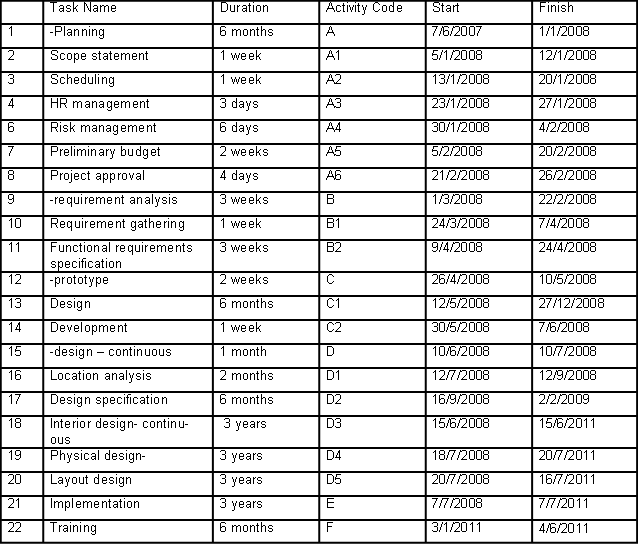

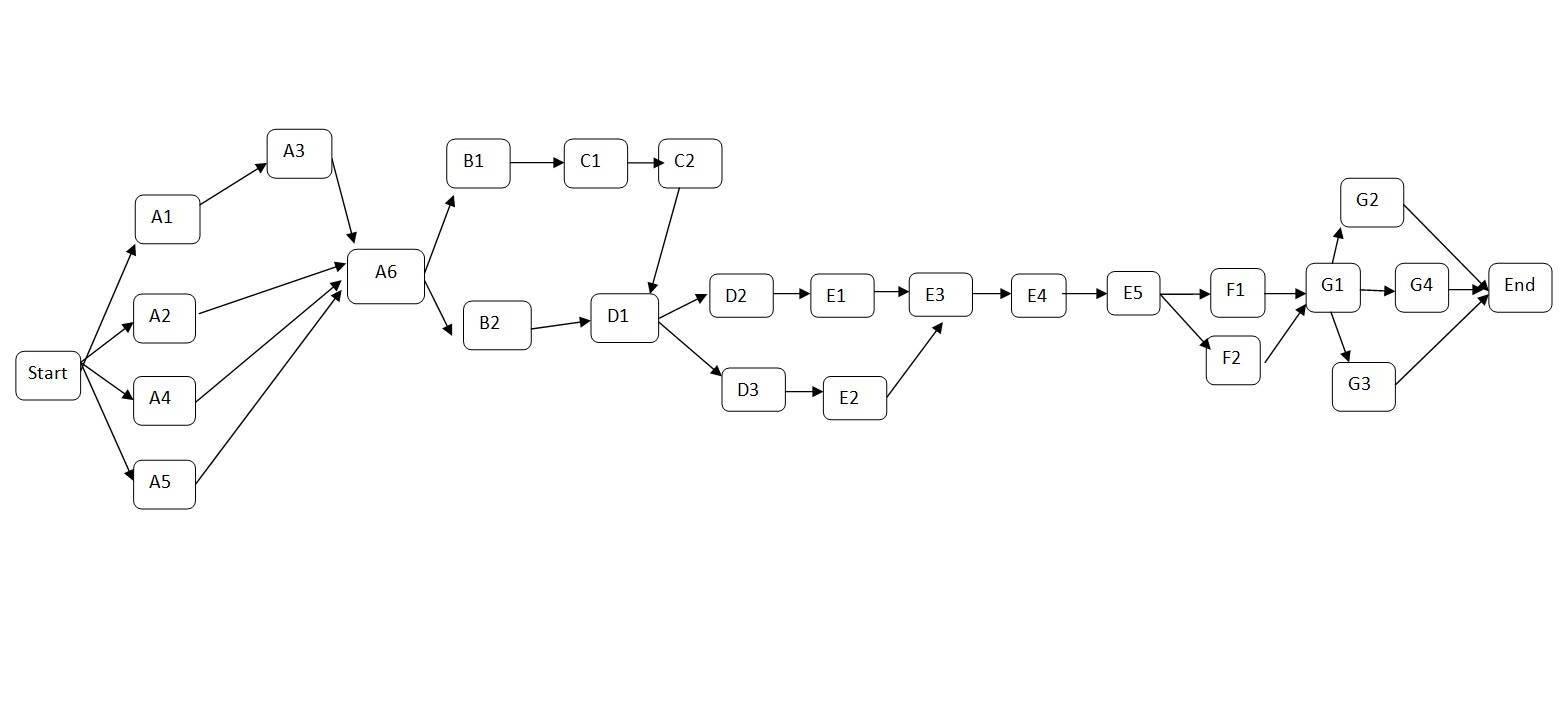
Human Resource Management Plan
After the completion of the scope of the project and the identification of activities, human resource management is utilized to realize roles, responsibilities and relationship of stakeholders. The major aim of any project is the human resource; for this reason, any viable project management plan must contain an HR plan (Stevens 23). The activities within this process involve;
Human Resource Requirement
Here, we have the various human resources needed for the various aspects of the project life cycle.
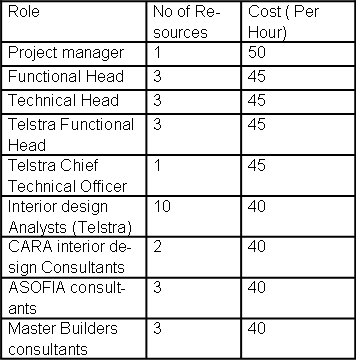
Training Requirements
The basic sales, retail and customer demonstration training based on the Telstra business process is given to CARA IPM and their consultants (Hanlon 12). This is done in order to provide them with a clear picture of the retail business processes at Telstra. The aim of this step is to give the interior designers and design team with an idea to create interactive retail stores for their customers and employees. Training and demonstration equipment used in the retail sector was provided, including laptops, projectors, internet, intranet, manuals etc.
Project Organizational Structure
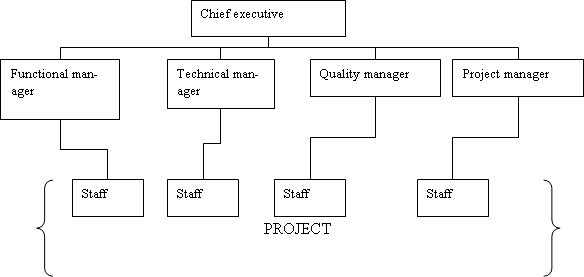
The organizational structure shows the project management team within Telstra. Within this team, the Company has a strong organizational structure, headed by the project manager who is responsible for all projects undertaken by the Company. Within this organization, it is expected that project teams or staff working on any project report to the project manager. Apart from this function, the manager is also responsible for the employees working on projects. The project teams report on functional aspects of the project like requirement gathering, requirement specification preparation, testing and implementation aspects, among others (Fuller 23).
The technical manager is often responsible for the technical aspects of the project; this can include the development, design and implementation activities. On the other hand, the quality manager is held responsible for the quality assurance aspects of the project (Fuller 19). Meanwhile, the project manager is expected to coordinate the projects teams as well as meet all resource requirements.
Task Responsibility Matrix
The matrix is designed to show the participation of the various responsibilities in meeting the objectives of the Telstra T [life] retail transformation project (Ireland 13). Within this matrix, the project details the responsibility of each of the Telstra’s manager according to the level of involvement.
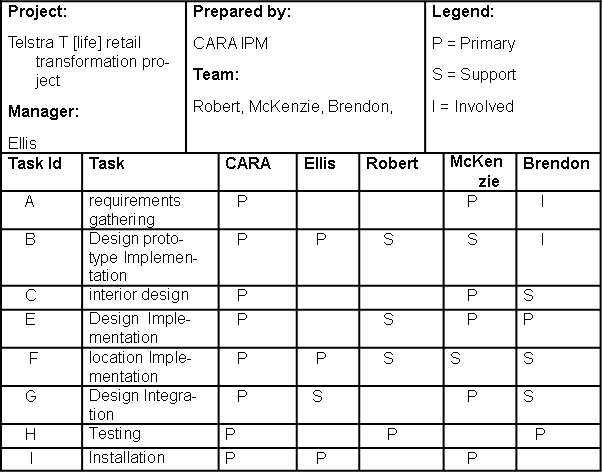
Project Communication Management Plan
This will provide a detailed plan for informing the project managers, teams and relevant stakeholders on relevant information.
Communication Matrix
The table below shows, in summary, the communication matrix for the Telstra T [life] project, detailing documents, schedules, work assignments and the distribution methods used.
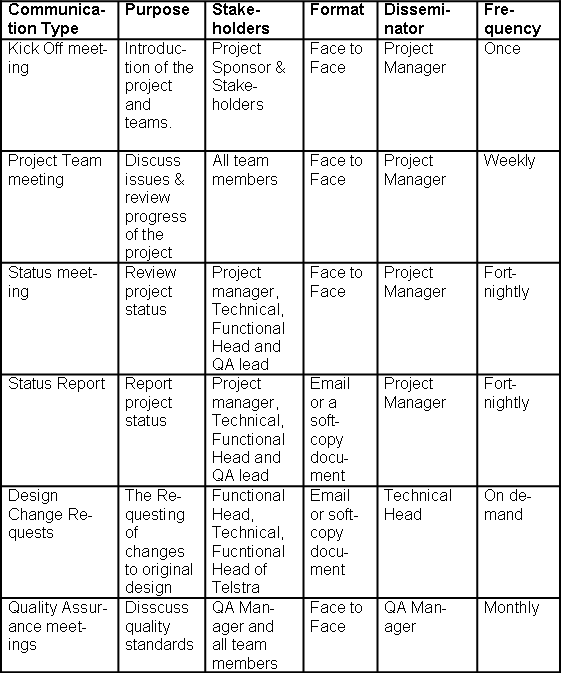
Escalation Mechanism
There are three levels under which the escalation mechanism will be used to communicate between CARA IPM and Telstra (Ellis 3). If an issue arises, it will be dealt with formally, where the first level will be contacted. If this communication fails, within the specified time, the issue will be raised with level to and so forth. The table below details this escalation process between CARA IPM and Telstra.
CARA IPM to Telstra

Project Cost Management Plan
Cost Estimates of Resources

Project Quality Management Plan
The issues created in the development of the transformation project from the beginning to the end are grouped in categories and their tolerance values assigned.
Quality Metrics
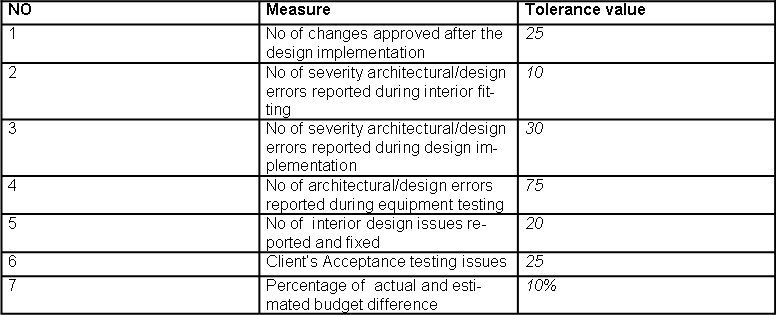
Quality Assurance Audit
This is performed to realize actual figures that are related to quality measures, whereby, alterations are defined in terms of frequency.
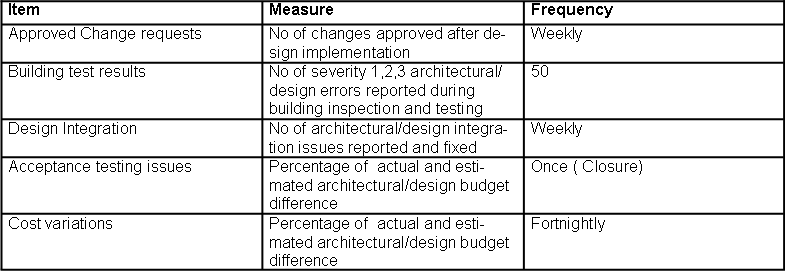
Quality Assurance Check List
The quality assurance team prepares a checklist to make sure that all transformation activities vital for quality assurance are carried out.

Project Risk Management Plan
Risk Register

Project Execution
Designing and Development
The initial stage of the execution of the project design will be done with the help of the design architects from CARA IPM and their consultants and sub-contractors. According to (Ellis 2), the execution is carried out based on the design plan that has been approved by the client and the interior design consultant. The location of the retail stores is based on the data obtained by the project team during the requirements gathering stage. Meanwhile, the interior design for the stores is based on the size of the building selected, the location of the building, environmental factors like demographics, customer preference and legal and political restrictions. Ideally, the interior design and implementation of the Telstra T [life] stores are based on the objectives of the client (Hanlon 2).
The design will make use of materials, layouts, lighting and colours that will create an interactive environment, give customers access to products and services and allow for demonstrations. Since heavy user involvement is required, the design will see a more centralized architectural and interior design.
Integration
Within this stage, the developed designs are integrated and tested (Lock 45). The main issue that arises at this stage is the integration of all the equipment and materials used in construction, interior design of the retail stores in such a manner that they give the customer an interactive environment. However, the building, renovation and design of the retail stores must still adhere to the building, health and safety standards as required by the Australian government. Having integrated all aspects of the stores, the next level is the testing stage.
Testing
Testing is carried out to make sure that there is adequate lighting, air circulation, insulation, proper plumbing, electrical wiring, internet connectivity, security and that the interior accessories give the stores a unique Telstra T [life] look.
Quality Assurance
Quality assurance is carried out at all levels to ensure that execution is carried out according to the project defined standards and benchmarks.
Project Monitoring and Control
Schedule control
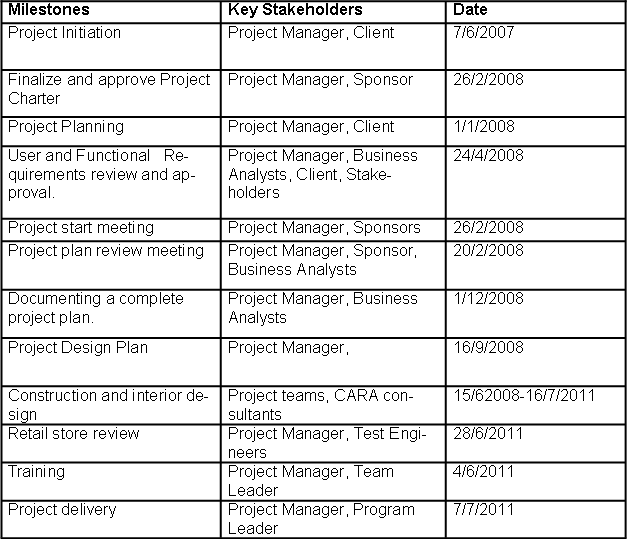
Cost Control
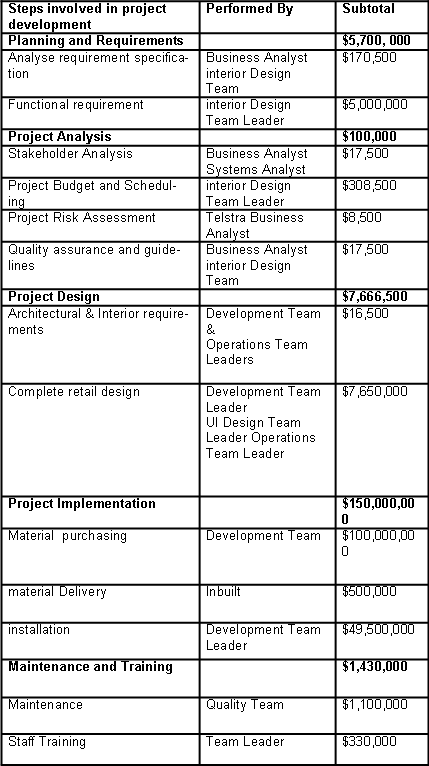
Quality Control
According to (Fuller 10), this is the degree at which the set of inherent characteristics meet requirements. The following testing processes will be used to determine the quality of the project;
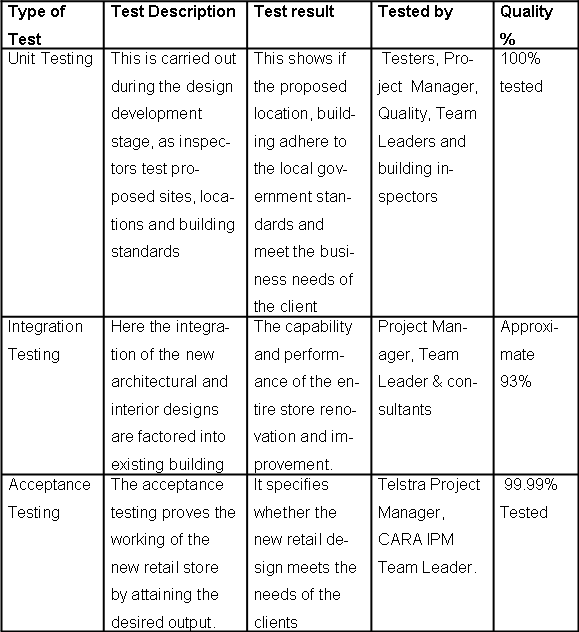
Scope Control
Only those changes that have been accepted are made to the project. These will be obtained from the control process, management plan and change request change. Each change is documented to describe the procedure at which it was arrived at.
Risk Monitoring and Control
Risk is monitored from the onset of the project, as the project management team tries to meet the needs of the client. It is noted that each change made in the project execution process increases the risk.
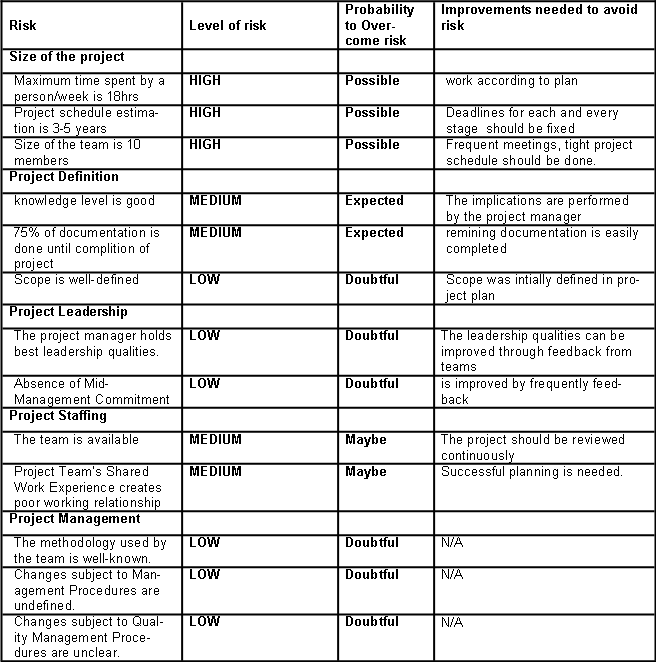
Project Closure
Project Performance
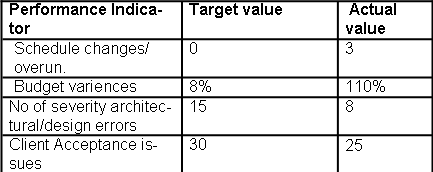
Customer Satisfaction Survey
The survey will give the response of the client to the completed project.
Give an explanation of why you are satisfied or dissatisfied with the project?
Response:
How likely are you satisfied with the deliverables of the project?
Response:
What are the recommendations to the Team in the implementation of the project?
Response:

Closure Meeting with Customer
This is for the purposes of the closure of the project and signing off the project.
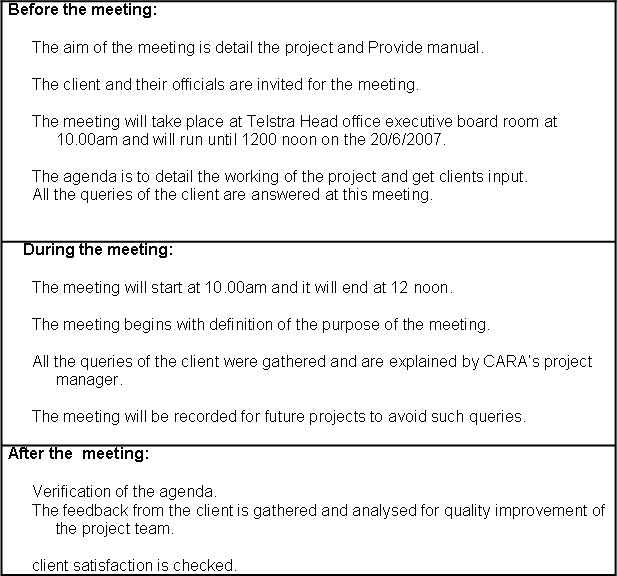
Post Implementation Review
Zero-order review
According to the customers’ needs, the project plan was changed to involve both hard and soft documentation processes for easier accountability and communication.
First order review
The project design was not altered during the process.
Lessons Learnt
Successes
- Able to create a customer-friendly retail store.
- Project completed within the expected timeline.
Failures
- Budget exceeded limit
- Planning and designing stage took longer than expected
Archiving project documents
Change Request form
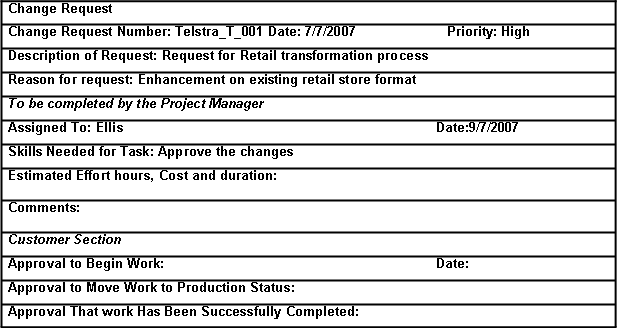
Escalation Mechanism
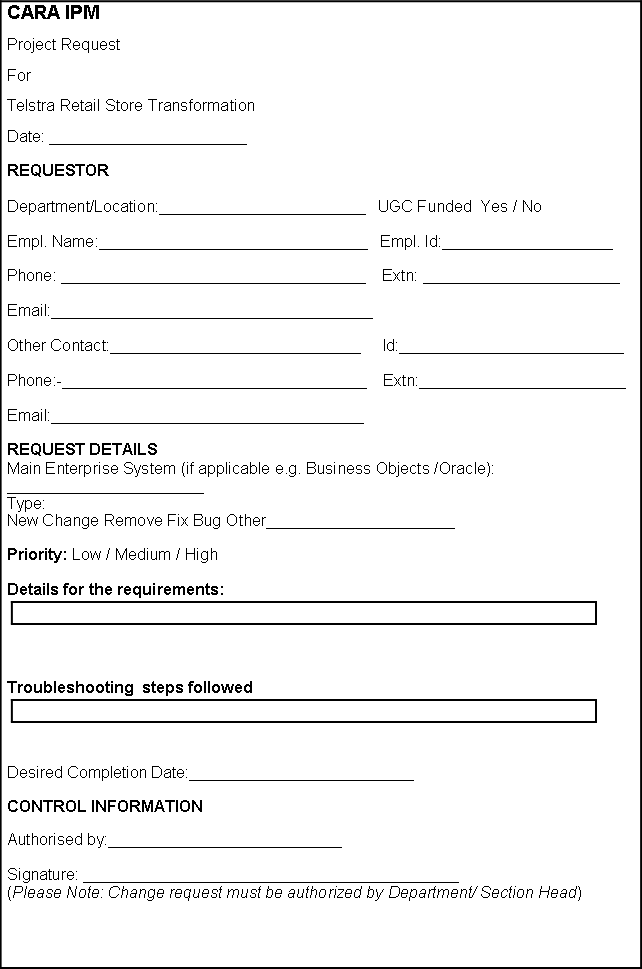
Works Cited
Ellis, Andy. Telstra’s Retail Transformation. 2011. Web.
Fuller, Mark., Valacich, Joe., and George, Joey. Information System Project Management: A Process and Team Approach, Pearson Education, New Jersey, 2008. Web.
Hamilton, Albert. Handbook of Project Management Procedures. New York: TTL Publishing, Ltd, 2004. Web.
Hanlon, Joseph. Telstra T [life] Melbourne. 2011. Web.
Ireland, Lewis. Project Management. London: McGraw-Hill Professional, 2006. Web.
Kerzner, Harold. Project Management: A Systems Approach to Planning, Scheduling, and Controlling 8th Edt. Melbourne: Wiley & Sons, 2003. Web.
Lock, Dennis. Project management 9th edit. UK: Gower Publishing, Ltd., 2007. Web.
Stevens, Martin. Project Management Pathways. New York: Association for Project Management, pub, 2002. Web.
Appendix 1
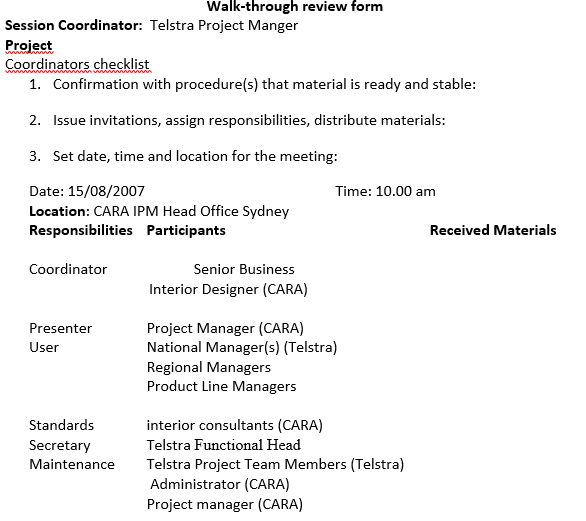
Appendix 2
